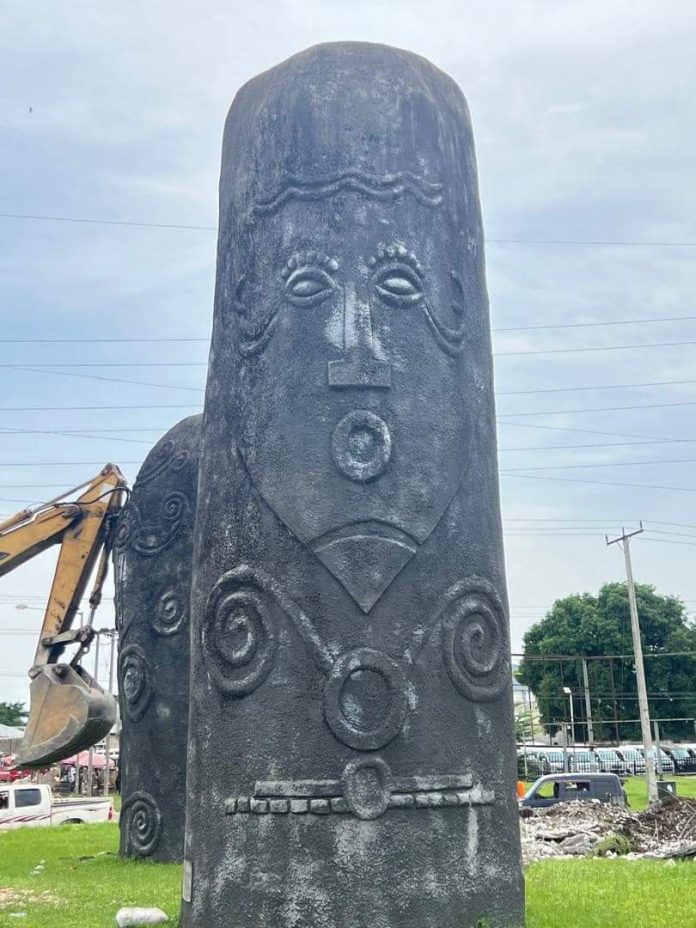The decision in this season of sweetness to replace the replicas of the Alok monoliths with the image of Jesus the Good Shepherd left a bitter taste in a few mouths. The government has largely ignored the feedback, proffering no explanation. Much like the Blind Men of Hindustan we the plebians grope for meaning. So this is how I see the elephant.
With Carbon dating variously placing the age of the monoliths between 1,500 to 4,500 years, these are the earliest relics of civilization in Africa South of the Sahara; as structures made of clay, wood and thatch did not survive the lapse of time. If the pyramids of Egypt or the Great wall of China were not made of stone, they would have been long gone. The Benin Earth Works, longer than the Great Wall of China, dissolved over time.
Made of stone the monoliths have stood the test of time, evidence that at the same time the Egyptians were building the pyramids, before Christ was born, black Africans were already organized in societies with political structures, law and order, and religion; that we had civilization. Our technology was advanced such that we had the implements to cut and shape volcanic rock creating stone obelisks of more than 6 feet long, moving them into location, carved into sculptures. We appreciated art.
To cut volcanic rock into such dimensions and carve them, you must have implements and tools harder than rock, like iron, the same metals the Egyptians used to cut the building blocks for the pyramids. But more intriguing is how these 6 foot stones were transported through tropical rainforest and placed into location. Even the more rampant four feet or three feet monoliths are quite heavy.
This means Africans south of the Sahara, the black man, 4,000, or 3000 years ago, had iron technology, knowledge of geometry and writing, and transportation technique. But above all these, we had societal organization to execute these monoliths projects; we had civilization. Same time as the Egyptians, at a time the Europeans were still roaming the plains as marauding bands; before the Anglo Saxons ever thought of crossing the English Channel to “discover” Britain.
To put it in context, the monoliths do not just show that the communities around Ikom had civilization, the monoliths represent the earliest relics of Africans living in organized societies from Gambia to Tanzania to Namibia to South Africa. May be the stone works of Tanzania and Gambia, and the Nubian Pyramids in Sudan can be mentioned here. The geometric images on the monoliths show that the makers had good knowledge of mathematics.
If the iron implements used in hewing and carving the rock were not smelted in Alok or that area, then the equipment must have been bought from other societies, or kingdoms that had iron technology. Trade is a big index of civilization because it shows peaceful interaction, a mutually acceptable medium of exchange, information flow etc.
It took sometime before the quarry where the Egyptians sourced the rocks that built the pyramid was discovered. Myth has it that the stones popped up from the river bed or streams; that’s myth. Finding the quarry for the monoliths can be done by studying the geomorphic makeup of the monoliths and tracing to corresponding rock types in the surrounding areas.
So the Alok or Ikom monoliths are perhaps the most important signposts of pre-imperialist African civilization. We do not sell the monoliths enough. We do not hype them otherwise the world would have been trooping here to see them. We have not even studied the monoliths enough. The replicas at the Zone 6 roundabout were not relics to idolatry but signposts of the earliest and outstanding African civilization.
Attah Ochinke Esq is a former Chair of the Nigerian Bar Association in Calabar









